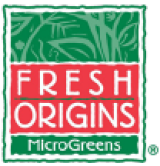


Giant Amaranth Leaf
Estimated Inventory, 50 ct : 0
This item was last sold on : 04/09/25
| Fresh Origins | Homepage |
Description/Taste
Giant Amaranth leaves are large, measuring approximately 8 to 10 centimeters, and boast a bold, tricolor pattern with varying vibrant hues of green, yellow, orange, and fuchsia. The leaves have a lanceolate shape that tapers to a point, prominent burgundy webbed veining, and ribboned edging, contributing to the elegant and delicate look of the leaf. The rainbow-colored leaves have a mildly vegetal aroma and a nutty flavor with vegetal undertones and a slightly salty finish.
Seasons/Availability
Giant Amaranth leaves are available year-round.
Current Facts
Giant Amaranth leaves are harvested from the topmost plumage of Joseph’s Coat Amaranth, botanically classified Amaranthus tricolor, a perennial herb that grows in tropical, sub-tropical, and moderate climates. The leaves are harvested from the top of the plant's long stems when they boast a vibrant, tri-colored ombre pattern. This variety of amaranth is also known as tricolor amaranth, fountain plant, and summer poinsettia. Giant Amaranth leaves are a part of a boutique line of specialty greens developed by Fresh Origins Farm in San Marcos, California. The plants are grown year-round and in-house in sprawling, sustainably-minded greenhouses. Giant Amaranth leaves are designed to add flavor and texture to a variety of sweet and savory recipes and beverages.
Nutritional Value
Giant Amaranth leaves contain high levels of vitamin C, an antioxidant that boosts the immune system and helps to protect cells from free radicals, as well as vitamin A, a nutrient that supports many functions in the body, including vision, growth, cell division, and reproduction. Amaranth greens also have one of the highest concentrations of vitamin K, which plays a vital role in strengthening bones and blood clotting, and various minerals, including calcium, manganese, magnesium, and copper.
Applications
The mild flavor profile and stunning presentation of Giant Amaranth leaves make it ideal as a garnish, fresh bed for grilled meats or vegetables or mixed into salads for added flavor and texture. The delicate greens cannot withstand high heat and should be added at the end of the cooking process or during plating to prevent the leaves from wilting. The greens can be lightly dressed and served in salads or layered into wraps, sandwiches, and burgers. They can also be sprinkled over pasta and pizza, stirred into grain dishes, or served with cured meats like smoked salmon and charcuterie. Giant Amaranth leaves pair well with meats such as pork, poultry, turkey, and steak, fish, crustaceans, fruits such as pears, watermelon, and apples, maple syrup, and edible flowers. Giant Amaranth leaves will generally keep 5 to 7 days stored in the refrigerator in a sealed container.
Ethnic/Cultural Info
Joseph’s Coat Amaranth was introduced to Europe from Asia in the 16th century. The seeds were then brought to North America with colonists as they took over the region, where it naturalized and became a favored garden plant. One garden in particular, Monticello, is famous for displaying the vibrantly colored foliage of the amaranth variety. Monticello was the primary residence and plantation of Thomas Jefferson, the third President of the United States of America and one of the nation’s founding fathers. Thomas Jefferson documented the vibrant plant in his garden book, “Notes on the State of Virginia,” speaking to its beauty, and even sent seeds from the tri-color amaranth grown on the grounds to his brother-in-law in Paris in 1786. The home and its surrounding grounds were maintained by slave labor, and much scrutiny has fallen on the legacy of Monticello as information regarding Thomas Jefferson and his relationships with his slaves has come to light, however, this has not stopped the home from being a place of historical significance, receiving thousands of visitors every year. Monticello is no longer a working plantation but has, instead, been turned into a World Heritage Site that continues to operate as a museum and education institution. Tours are given of the famous gardens, and Joseph’s Coat Amaranth can still be found growing on the grounds at Monticello, blooming vibrantly in the summer months.
Geography/History
The original amaranth is native to Peru, where the leafy green has been domesticated for over 6,000 years. The plant was brought to Europe, Asia, and Africa by colonists returning from South America, and the greens quickly naturalized in these regions. Tricolor amaranth is native to tropical Asia and can now be found growing throughout Asia, North and South America, and parts of Europe. Giant Amaranth leaves were developed at Fresh Origins, a farm in San Marcos, California, the leading producer of naturally grown microgreens since the mid-1990s. Fresh Origins also has the highest level of a third-party-audited food safety program and is a certified member of the California Leafy Greens Marketing Agreement, which follows science-based food safety practices to promote transparency and honesty in production. The temperate climate of southern California allows Fresh Origins to produce their high-quality greens year-round, supplying produce retailers and chefs directly throughout the United States and Canada.




 Learn More...
Learn More...
